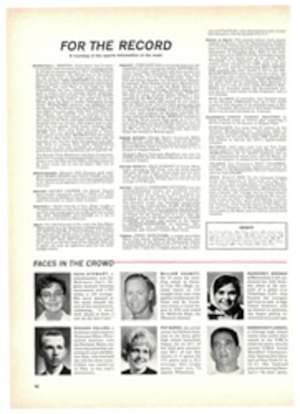
HI JOE, WHERE ARE YOU?
Until Hi Joe is found," said Detective Sergeant Peter Jarrott, summing up the matter in the firm way of British policemen, "the case will never be closed." And that, it began to seem, was that. After he and a small army of fellow gumshoes had combed the British countryside in vain for two whole weeks, Jarrott was only able to add: "Let's face it. I don't know where the dog has gone."
The disappearance of the most popular racing greyhound in all England had been noticed first by his trainer, Miss Noreen Collin of the Forest Cottage kennels, on the night of January 2. Miss Collin had just returned to Epping from London's White City Stadium. "As I drove in the gate," she said later, "and saw the shed door was open, I somehow knew. All I could think was—Hi Joe."
Noreen raced to the back of her house where her six kennels stood—each one individually padlocked and all protected by another padlock on the door of the shed that housed them. She found that the padlock securing the shed had been neatly severed with a bolt-cutter. Whoever cut it apparently had then gone straight to the last kennel on the right, which housed a bitch named Paula's Pal, herself a highly valuable animal, and the dog called Hi Joe, a sleek little (63 pounds) speedster who was already the 10-to-l favorite to win Britain's richest greyhound race, The Derby, in June. Paula's Pal was still in her kennel when Noreen got there. Hi Joe, the best-known puppy in the land, was gone.
Who had taken him? And why? And how?
"This is our affair now," Noreen's kennel manager, Wilfred Lambert, told police the night of the theft, "but tomorrow morning it will be the whole nation's worry."
He was right. By the middle of the following day, the cottage at Epping was besieged by television crews and newsmen. A general description of the dog was distributed to police throughout the country, and an intensive watch was established at seaports and air terminals. Two ex-Scotland Yard men employed by the National Greyhound Racing Society began combing contacts in the underworld. None of them turned up a trace of Hi Joe.
The thief or thieves apparently had driven up in a car around 8 p.m. but nobody in Forest Cottage or nearby had seen them. Noreen had left for White City at 4 o'clock. Lambert had followed an hour and a half later, leaving the kennels locked but unsupervised except by Noreen's elderly aunt, Winitred Howlett, a lady of 80 who was in the house sick abed with the flu. At 8, Aunt Winifred had been joined by a neighbor lady of 77 and the neighbor's 13-year-old niece. They were all upstairs together when they heard the three house dogs barking. "Probably a cat," said someone. But Mrs. Coleman, the neighbor, went down to have a look anyway. She found the shed door and the garden gate both open, and she heard a car driving away. But rather than disturb Aunt Winifred by calling the police, she decided to do nothing until Noreen got home, thus giving the thieves a three-hour start. While police endeavored to pick up their traces, the nation wondered at their motives.
Irish-born and the property of a prosperous bookmaker named Victor Chandler, 2-year-old Hi Joe was just reaching his peak as a racer when he was stolen. In the brief period he was under Noreen Collin's charge, he won 10 out of 14 races, and all of his last six. Remarkably consistent, he raced round White City's 525-yard track in 28.72 seconds, faster than any puppy before him, and then went back a fortnight later to repeat the performance. Named the Puppy of 1964, he had easily defeated all the other highly rated greyhounds in his class in a special race only three days before he was stolen. His achievements suggested that he might eventually outshine even the legendary Mick the Miller, a dog bred by an Irish priest, who set an alltime record of 19 consecutive wins in 1930, won the Greyhound Derby two years running and now stands proudly stuffed in the Natural History Museum in South Kensington, London.
Hi Joe's value before the theft was put in the vicinity of $14,000. Depending on how he performed during the important part of the racing season (greyhound racing goes on all year long in England), it might have grown to much more. A comparable dog named Lucky Hi There is valued at nearly $30,000. Lucky won 16 consecutive races and, now retired, commands a stud fee of 50 guineas ($147). Noreen Collin believes that they might have been able to charge 100 guineas for Hi Joe's stud services when he retired, which could reach a sizable figure if Hi Joe were to service a bitch a day.
In Britain, greyhound racing is big business, the second-largest spectator sport after soccer. Although attendance has dropped since the postwar boom, a situation reflected in other sports as well, 12 million people attended dog meetings last year, and it has even become fashionable to own a greyhound. On and off the track, approximately $300 million is bet annually on the dogs.
Small wonder then that there was national concern over Hi Joe, who was scarcely gone from his kennel before bookmakers in Ireland began taking bets on where he would be found. Many bettors favored Glasgow's bush-league "flapping" tracks, those small greyhound racing strips unaffiliated with the National Greyhound Racing Society. This theory soared momentarily when a truck driver reported that he had seen two men exercising a black dog beside a Jaguar on M6, the main high-speed road to Scotland, but it collapsed when police checked the license number of the car the trucker said he had seen. The number was out of service.
To wiser heads, the idea of Hi Joe running at a flapping track or anywhere else seemed pretty ridiculous, particularly in the light of the $1,400 reward (later doubled) offered by owner Chandler for the return of the dog with no questions asked. With the whole British population on the lookout, such an outstanding performer might be expected to arouse a certain amount of suspicion. Even if Hi Joe were dyed pea green, he had other characteristics much more difficult to disguise. There was a bone in his forehead that gave his head an odd, easily recognized shape. On his left ear he was tattooed with the letters VHX, a code marking similar to one given all greyhounds born and bred in Ireland. Even if this could be obliterated, Hi Joe's toes would remain as the final giveaway. The National Greyhound Racing Club in London has an exact record of the pigmentation of every single toe on Hi Joe's paws, and this is as effective a method of identification as a man's fingerprints.
But to match paw pigments, one needs paws. At the end of two weeks slender threads had taken the chase to Wales, up to Scotland and down to Kent, but nothing concrete materialized. A black great Dane, glimpsed briefly in a car and mistaken for a greyhound, set the police on one of many fruitless investigations. In Glamorganshire, a greyhound answering to Hi Joe's general description was found running loose on the mountainside but it was another dog altogether. There was a macabre report that the body of a racing greyhound with its feet cut off had been found at the bottom of the cliffs at Hove on the English south coast. It turned out to be a poodle. A wild, unconfirmed rumor suggested that the dog had been shipped to Spain or Portugal, where an animal as magnificent as Hi Joe would practically lap the field. And in Whitstable, Kent, a 79-year-old astrologer named Rupert Cobb studied the stars and gave it as his opinion that the dog was in the English Midlands.
The most recent and most favored theory is that the dog has gone—or will soon go—to America. An investigator said: "It seems the only logical conclusion." If any U.S. reader notices a dog fitting Hi Joe's description in Tampa, Colorado Springs or Taunton, Mass., try calling him over. If he is Hi Joe, he will answer to his nickname: Archie.
PHOTO
PHOTO
Trainer Noreen Collin suspected foul play when she spotted the open kennel door.

